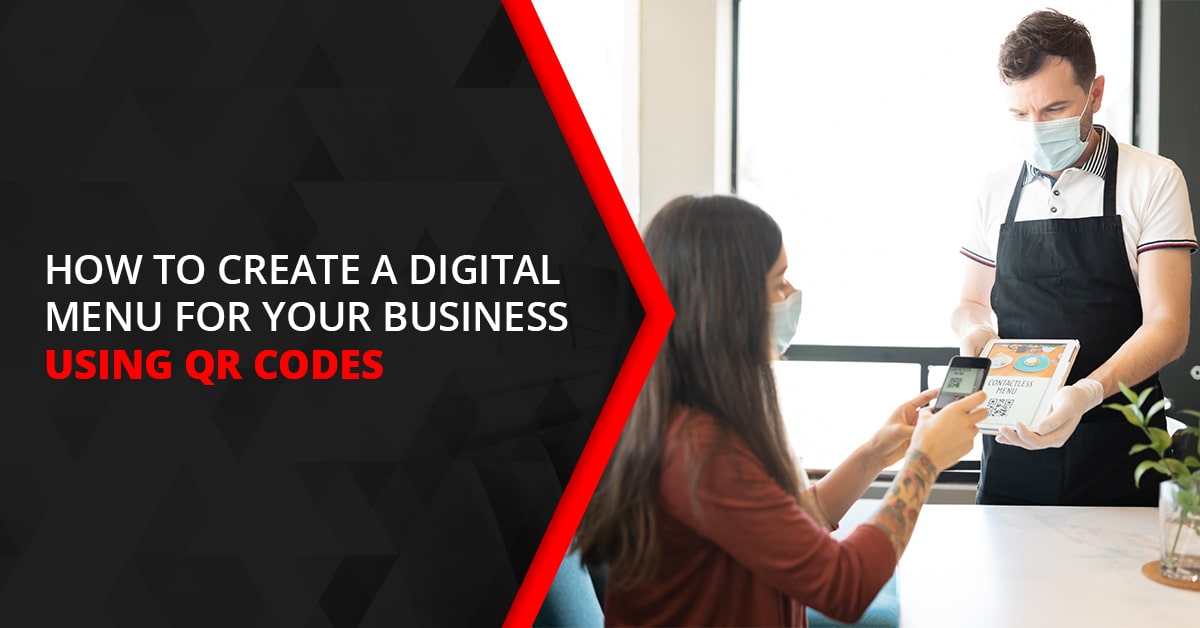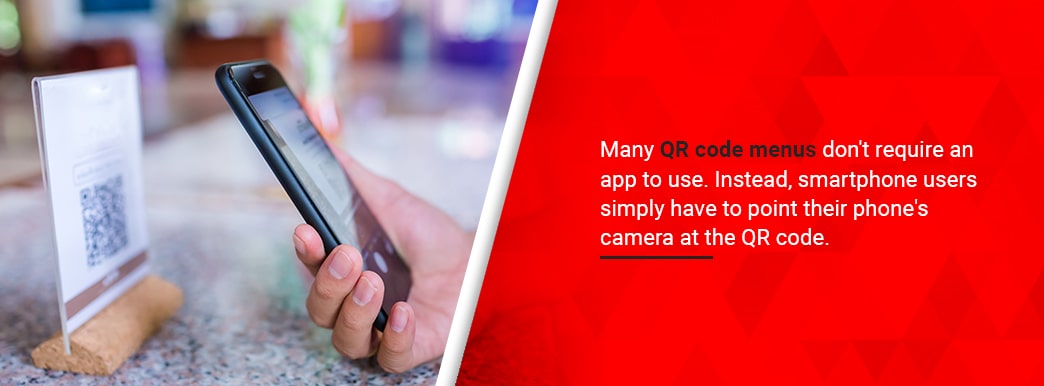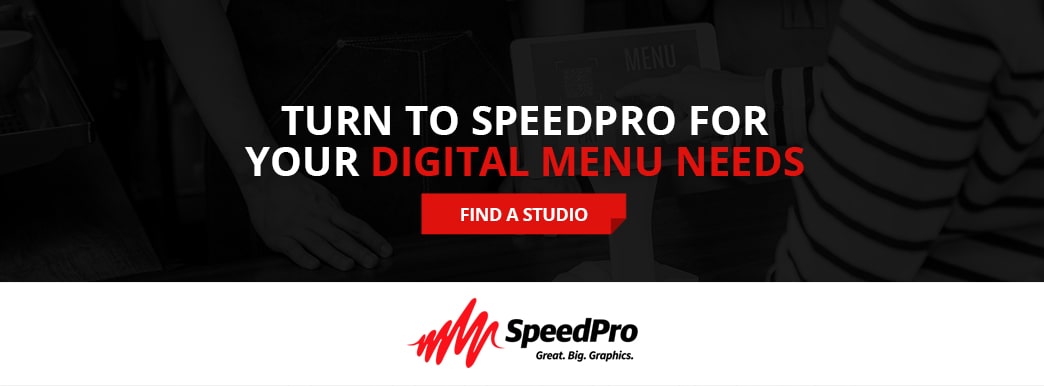
How to Create a Digital Menu for Your Business Using QR Codes
AUGUST 12, 2021| SpeedProCategories
Smart SignageWith many restaurants switching to digital menus for greater sanitation and branding, you may want to know how you can create a virtual menu and implement it at your restaurant. Quick response (QR) codes are the gold standard for businesses switching to digital menus, as they allow diners to access your menus on their smartphones.
If you’re interested in adding QR code menus to your restaurant, learn the steps you’ll need to take to implement them successfully. You might also want to learn more about what QR codes are, why you might use them and tips for creating them.
What Are QR Codes?
QR Codes look much like cubist bar codes and are 2D images users can scan with a smartphone camera or app. After scanning, the QR code will direct the user to a predetermined website link or another piece of information. As a type of smart signage, QR code menus allow users to simply scan a code on their table with their phone and immediately have a menu pop up on their screen.
Many QR code menus don’t require an app to use. Instead, smartphone users simply have to point their phone’s camera at the QR code. After the camera scans the code, a clickable notification will appear which will direct the user to a web page featuring the restaurant’s menu, allowing them to browse the menu’s drink and food offerings with ease.
Why Use Digital Menus With QR Codes?
With COVID-19 dining restrictions still in place in some areas, digital menus with QR codes can help your business protect your staff and customers. A QR code menu for your restaurant allows you to reduce contact between diners and servers. These contractless menus also eliminate the need to clean menus after every use. As a result, QR codes are a perfect choice for restaurants looking to increase their sanitary efforts.
Even after dining restrictions are fully lifted, contactless menus can be an excellent investment for your business. By moving to digital menus, you won’t have to replace damaged physical menus. When your menu changes, you can also easily update your digital menu. This easy edit allows you to save money and time since you won’t have to pay for new menus or wait for them to arrive.
Alongside their financial benefits, digital menus help you brand your business as forward-thinking. Due to these menus’ high-tech appearance, you can attract customers who want an innovative dining experience. Digital menus also free your staff up for other tasks, as they won’t have to bring menus to the table or clean dirty menus.
How to Create QR Code Menus
If contactless QR code menus sound like an option you’re interested in, you need to know how to implement them at your restaurant. To create QR code menus, follow a few steps to ensure you get the best product possible. Here are the main steps to make QR code menus:
1. Upload an Online Menu
Since a QR code will send users to a web page, the first step to creating QR code menus is placing your menu online. Without an online page to send users to, your QR code will be useless. By uploading your menu to the internet, you create a destination where the QR code can direct users.
If you already have an online menu or offer online ordering, you’ll already be prepared to implement a QR code. However, restaurants without an existing online menu will need to digitize their physical menu or create a new one with design software. Once you create your new menu, you can upload it to a web page.
Whether you need to create a new online menu or you already have one, it’s important to make sure it’s optimized for a touchless experience. To optimize your contactless QR code menu, check that it includes these features:
- Listed prices: Unless your restaurant purposely doesn’t list your food and drink prices, you’ll want to ensure your online menu has the prices listed. Sometimes, online menus only showcase what the restaurant has to offer and not the pricing. Since your customers will need to use your online menu when dining at your restaurant, listing your prices is crucial.
- Mobile-friendly menus: Your customers will be viewing your menu from their smartphones, so it’s important your menu is easy for them to read on their mobile devices. For instance, you’ll want to avoid listing too many food options on one page. Placing all of your items on one page makes your users scroll and zoom a lot to find what they want. It’s best practice to separate your menu offerings by course and in a larger text to ensure they’re easy to read.
- Non-PDF formatted: Many restaurants upload their online menus as a PDF. Unfortunately, many PDF files aren’t mobile-friendly and don’t allow you to edit them on the fly. Instead of formatting your menu as a PDF, choose a file format that’s mobile-friendly and easy to update on short notice. The right file format will allow you to change your menu quickly if an item isn’t available or reflect any specials you’re currently offering.
2. Create Your QR Code
After you’ve uploaded your online menu, it’s time to create your QR code. You can find several free QR code generators available on the market today. With these generators, all you’ll have to do is input the URL to your menu’s web page, and the program turns it into a scannable QR code image.
Some restaurants have multiple menus, such as those specifically for drinks or for different times of the day. If you have multiple menus on separate web pages, you can easily create multiple QR codes for your needs. Multiple QR codes are perfect for restaurants that only offer certain items at specific times, such as a brunch menu on weekends, or those that list beverage and food offerings separately.
3. Test Your QR Code
Before you place your QR codes throughout your business, ensure they work. To test your QR codes, use multiple types of smartphones to make sure their operating systems work with your QR codes. If a QR code sends various smartphones to the correct web page and menu, you can move on to installing your QR code at your business.
4. Design Your QR Code Signage
With your QR code created, you may want an imaging studio to help you create attractive signage to pair with it. In addition to customizing the code’s appearance, you can place imagery and text around it. By mounting a QR code on a larger sign, you can direct diners to use it to access relevant menus. For example, you might include some text identifying a QR code as the drink menu and encouraging customers to scan it. If customizing the code’s appearance, we recommend another round of testing to ensure the changes do not impact the usability of the QR code.
Besides including functional text on your QR code signage, you can also use it to brand your space. For example, you can surround the QR code with on-brand colors and attractive designs fitting the rest of your restaurant. Additionally, you can place unique imagery and your logo on the sign to increase brand awareness. If you plan to use multiple QR codes, you can even create a specific sign design for each of them.
5. Install Your QR Code Signs Throughout Your Business
After you’ve tested your QR code and created your QR code signage, the last step you’ll need to take is to install your QR codes throughout your business. Some of the most popular installation areas include placing QR code graphics on a restaurant’s tables or bar. Some restaurants also like to install them on their walls and at their entranceway.
Here are some other popular places to put QR codes menus and the types of signs you can use:
- Tabletop tents and inserts: Some of the most popular destinations for QR codes are on tabletop inserts and tents. Since you can place tabletop inserts and tents on every table at your restaurant, they give diners a convenient way to scan your codes. Tabletop inserts are the more sanitary option, as they get placed inside a plastic holder instead of standing on their own like tabletop tents. With your code inside the plastic holder, you can easily clean it between dining parties.
- Table coverings: While inserts and tents are great options, you can also use coverings on your restaurant’s tables to give users an easy way to find your menu. You can design table coverings with QR codes and branded imagery that you apply directly to your table. These coverings can be cleaned and won’t clutter up a table, as the QR code is displayed on the table’s surface.
- Indoor wall signage: Another excellent option is placing your QR codes on indoor wall signage. When you place the QR code on an indoor sign, users can simply walk up to it and scan it. Since these signs are mounted on the wall, they can be very eye-catching, helping you improve your restaurant’s look and deliver your menu to customers. Indoor signage is often placed in the entranceway or by the bar to help people get a look at the menu before they’re seated.
- A-frame sidewalk signs: If your business is on a street with lots of foot traffic, A-frame signs are an excellent choice for QR-code signage. A-frames stand on their own and can be customized with various designs and graphics to draw people’s attention to them. When you place them outside your restaurant’s entrance, people passing by can quickly scan the QR code and see your menu. By providing a simple and easy way to access your menu, you raise the chances passers-by will come inside to dine.
- Window decals: Like A-frames, window decals give your restaurant the chance to snag potential diners as they walk by your restaurant. These decals stick to your windows, with graphics and your QR code pointed out to the street. After viewers see your window graphics, they can scan the QR code to check out your menu’s offerings.
- Digital signs: Another great option for QR codes is to place them on digital signs. These signs are on monitors that display sleek graphics. Since digital signs can rotate through multiple graphics, you can easily display relevant QR codes for the time of the day or changing menu offerings. For example, you can use a digital sign to display a brunch menu QR code in the morning and then rotate to a dinner menu QR code in the evening.
Tips for Creating a Digital Menu With QR Codes
As you prepare to create QR code menus, you may want to know the best practices for ensuring they look and perform at their best. Here are some of our best tips for creating a digital menu with QR codes:
- Use the right text: Your QR code should have some text around it to help people know what it will link them to. Using text that provides some context and identifies where the QR code will link them can increase the chances people use the codes. If you think your target audience won’t know how to use QR codes, you can also include text explaining what they need to do to access your virtual menu.
- Pay attention to the QR code’s size: Since people need to scan your QR code to see the menu, it’s important you size the code correctly. You’ll want to print out larger QR codes when people will be farther away to scan them. If you have a tabletop QR code or another type of graphic that’s close for scanning, you’ll want your QR code to be at least 1 inch by 1 inch.
- Brand the QR codes: QR codes don’t just have to be black and white. Instead, you can craft QR codes in colors that match your brand and draw attention to them. Besides adding new brand-friendly colors, you can include logos and various designs on them. If you want to keep your QR code simple, you can leave it in black and white, placing branded designs, colors and logos around the QR code.
Turn to SpeedPro for Your Digital Menu Needs
If you’re interested in QR code menus for restaurants, SpeedPro can help. With our large nationwide network of printing studios, we’re confident we can assist you as you develop eye-catching and on-brand QR code signage for your business. Since we value innovation, we can also help you develop many different kinds of smart signage to help you upgrade your restaurant. When you turn to us for your needs, you can expect our team to work with you to develop signage perfect for your business.
Take a moment to learn more about our QR code signage capabilities. If you have any questions or are interested in a free quote, please contact your local SpeedPro studio.


















![How to Create QR Code Menus [steps]](/wp-content/uploads/2021/07/03-How-to-Create-QR-Code-Menus-RE-1.jpg)
![Tips for Creating a Digital Menu with QR Codes [list]](/wp-content/uploads/2021/07/04-Tips-for-Creating-a-Digital-Menu-With-QR-Codes-min.jpg)
